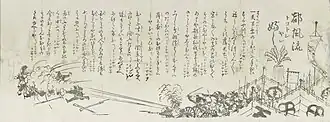Miyasan, Miyasan
 The songs lyrics, c. 1868 | |
| Lyrics | Shinagawa Yajirō, c. 1868 |
|---|---|
| Published | c. 1868 |
"Miyasan, Miyasan" (宮さん宮さん)[note 1], was a loyalist song, popular during the Boshin War.[3] It is also Japan's oldest military song.[4][5]
Overview
The lyrics refer to Prince Arisugawa Taruhito, or "Miya-san" in the song.[6][7] He was an influential figure in the Meiji Restoration.[8][9] He was also the Grand Governor of the Eastern Expedition| during the war.[10] The lyrics represent the spirits of the new government forces[10] which was the military forces belonging to the emperor and the Imperial Court.
In January 1868, the new government forces, formed from the three domains of Satsuma, Choshu, and Tosa and the respective lords of each province, fought and won the Battle of Toba-Fushimi against the old shogunate forces.[9] The following month, the new government's president, Prince Arisugawa Taruhito, also serving as the Grand Governor-General of the Eastern Expedition, was given a brocaded flag and a ceremonial sword by Emperor Meiji, and began marching along the Tokaido Highway.[9] All these events are mentioned in the songs lyrics.
Lyrics
| Japanese | Transliteration into rōmaji | English translation |
|---|---|---|
宮さん宮さんお馬の前に |
Miya san miya san o uma no mae ni |
My Lord, my Lord, in front of the horse |
Notes
- ^ i.e. "to the east": After the Fall of Osaka Castle, Tokugawa Yoshinobu fled east to Edo.
References
- ^ "Bob Bernard's Corner: Cross-Cultural Appropriation".
- ^ https://www.free-scores.com/download-sheet-music.php?pdf=22024#google_vignette.
{{cite web}}: Missing or empty|title=(help) - ^ "SHINAGAWA Yajiro | Portraits of Modern Japanese Historical Figures | National Diet Library, Japan". Portraits of Modern Japanese Historical Figures. Retrieved 2024-12-26.
- ^ 卜田隆嗣「軍歌」『日本大百科全書 7』小学館、1986年1月1日 初版第一刷発行、ISBN 4-09-526007-6、786頁。
- ^ 山住正己「軍歌」『世界大百科事典 8』平凡社、2007年9月1日 改訂新版発行、370~371頁。
- ^ Sheldon, Charles D. (February 1974). "Boshin sensō (The Boshin War.) By Haracuchi Kiyoshi. Tokyo: Hanawa Shobō, 1963. 269 pp. ¥460. - Boshin sensōshi (A History of the Boshin War.) By Hirao Michio. Tokyo: Misaki Shobō, 1971. 229 pp. ¥ 1,500". The Journal of Asian Studies. 33 (2): 314–316. doi:10.2307/2052202. ISSN 0021-9118. JSTOR 2052202.
- ^ "About Miyasan (Tonyare-Bushi)". daisyfield.com. Retrieved 2024-12-26.
- ^ Dupuy, Trevor N. (Trevor Nevitt) (1992). The encyclopedia of military biography. Internet Archive. London : I.B. Tauris. ISBN 978-1-85043-569-3.
- ^ a b c Keene, Donald (2002). Emperor of Japan : Meiji and His world, 1852-1912. Internet Archive. New York : Columbia University Press. ISBN 978-0-231-12340-2.
{{cite book}}: CS1 maint: publisher location (link) - ^ a b ymonjo.ysn21.jp http://web.archive.org/web/20150402170944/http://ymonjo.ysn21.jp/user_data/upload/File/ags/4-1-5-040.pdf. Archived from the original (PDF) on 2015-04-02. Retrieved 2024-12-26.
{{cite web}}: Missing or empty|title=(help) - ^ "Japanese Military & Patriotic Songs - 宮さん宮さん (Miya san miya san) (Transliteration #2)". lyricstranslate.com. Retrieved 2024-12-26.
- ^ "miyakoharumi's "miyasanmiyasan" lyrics page". uta-net.com. Retrieved 2024-12-26.